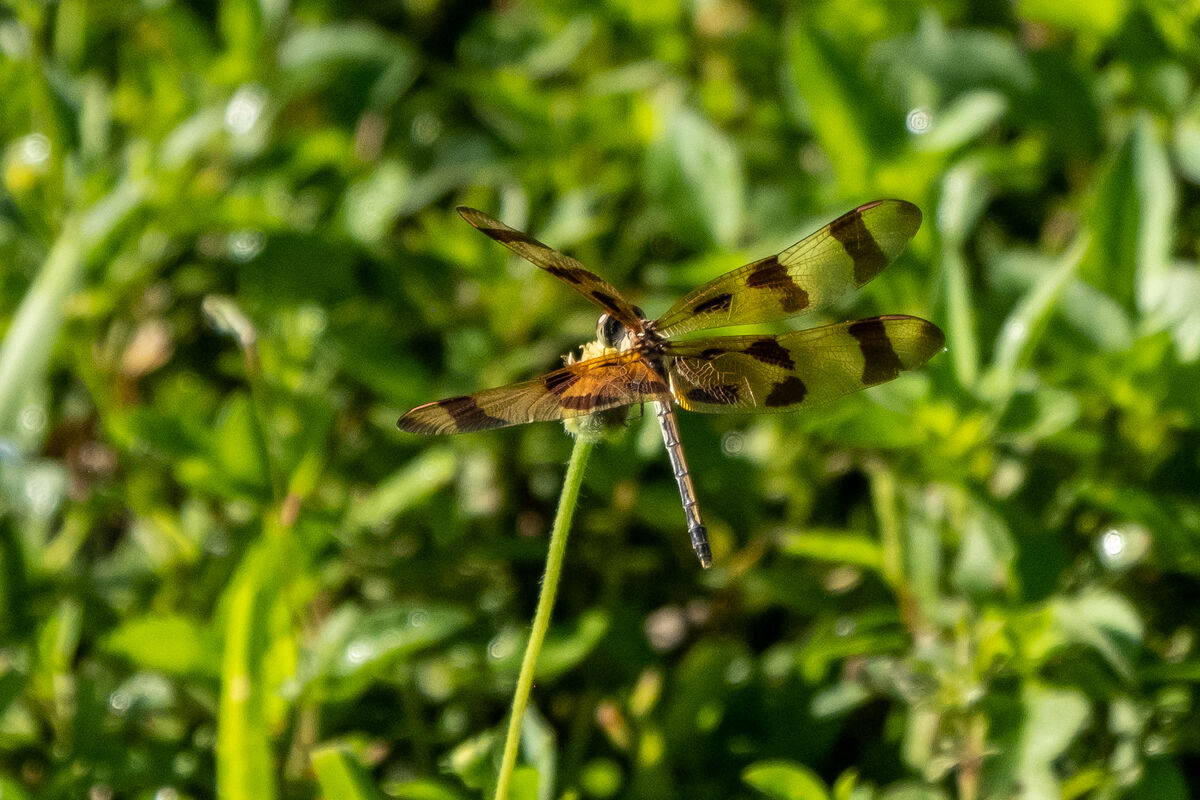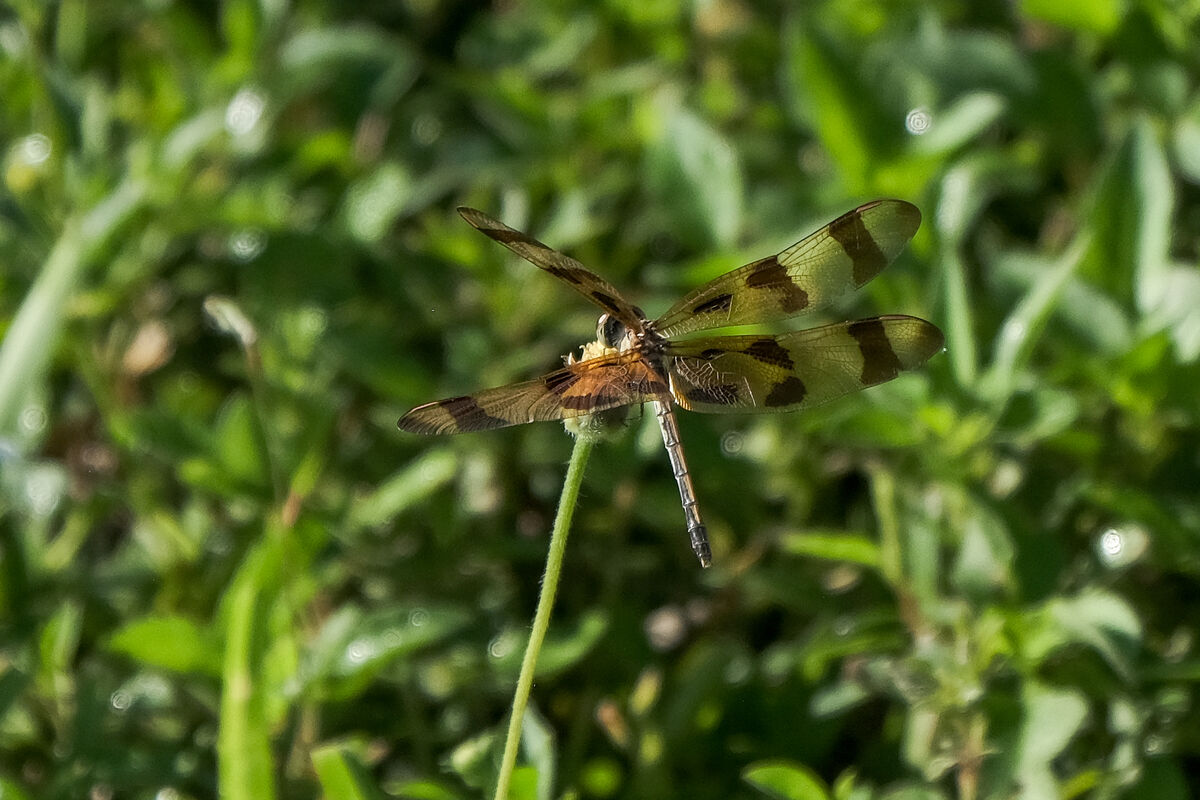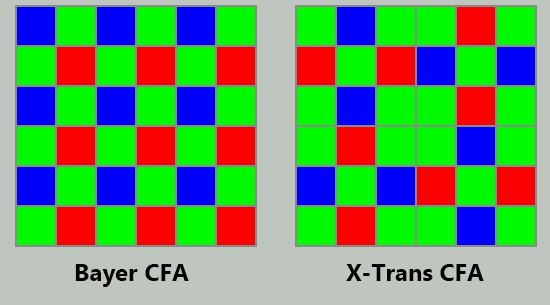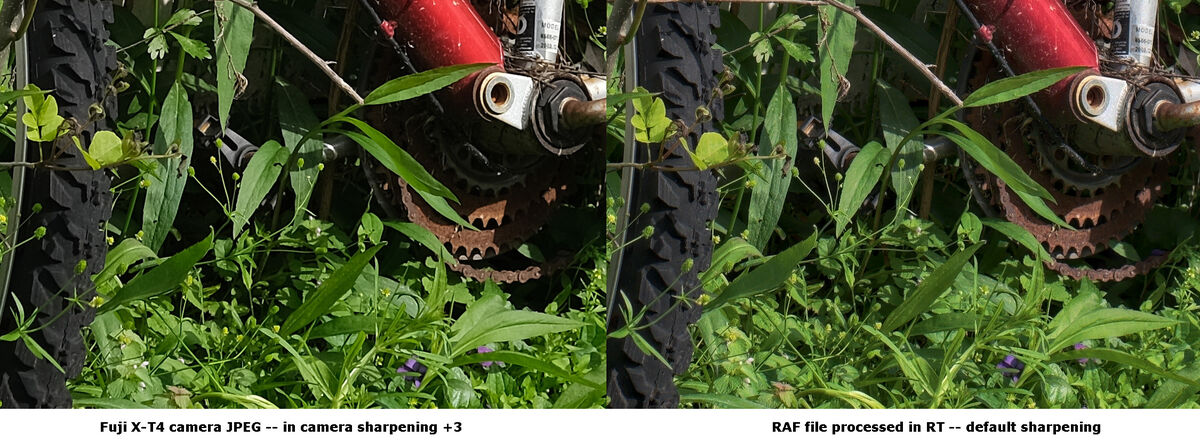Fujifilm XT-3: JPEG or RAW?
Aug 29, 2022 06:19:00 #
Empirical evidence only, the RAW pictures in Fujifilm XT-3 have a little bit more contrast and much more saturation; it looks better - most of the time - than the JPEG (of course without any processing).
But it took me by surprise how much more detailed the JPEGs are, look at the same photo below, JPEG and RAW. The wings have a lot more detail (both pictures were cropped at the same ratio). Film Simulation set to Eterna.
Any thoughts?
But it took me by surprise how much more detailed the JPEGs are, look at the same photo below, JPEG and RAW. The wings have a lot more detail (both pictures were cropped at the same ratio). Film Simulation set to Eterna.
Any thoughts?
Aug 29, 2022 06:30:00 #
It looks like perhaps you didn't adjust your jpeg in-camera settings.
Aug 29, 2022 07:16:00 #
Not surprised to hear what you say. I have two Fuji X-T2 bodies and an X-T30 (same sensor and processor as your X-T3). Switched to Fuji from Canon back in 2014 because Fuji sensors and processors produced such stunning jpegs. Fuji's film simulations, available only in jpeg, add to the beauty of their jpegs. I am a Leicaphile going back to 1950 and recently rented a Leica Q2 for the second time. Compared the Leica DNG and jpeg images to the Fuji jpegs and decided against buying the Leica (even with its 47 megapixel sensor and superb Leica Summilux lens). Sure, the Leica has more resolution but you have to enlarge to at least 200% to see it. I've had 30X40 prints made from Fuji jpeg files and they are quite satisfactory. Thanks for your post and comments.
Aug 29, 2022 07:31:28 #
An in camera JPEG is converted from the RAW file using the camera manufacturer's algorithm and any in camera setting that the shooter has made. If you shoot only JPEG (not RAW+JPEG) then the RAW file is not saved on your memory card (but it was produced to get the JPEG). So based on the manufacturer's algorithm, an in camera JPEG typically includes some sharpening, noise reduction, etc.
Your processing of the RAW file can achieve the same results if you knew the algorithm but you should be able to achieve much better results after learning how to do postprocessing.
Your processing of the RAW file can achieve the same results if you knew the algorithm but you should be able to achieve much better results after learning how to do postprocessing.
Aug 29, 2022 07:52:21 #
Ysarex
Loc: St. Louis
sergiohm wrote:
Empirical evidence only, the RAW pictures in Fujifilm XT-3 have a little bit more contrast and much more saturation; it looks better - most of the time - than the JPEG (of course without any processing).
But it took me by surprise how much more detailed the JPEGs are, look at the same photo below, JPEG and RAW. The wings have a lot more detail (both pictures were cropped at the same ratio). Film Simulation set to Eterna.
Any thoughts?
But it took me by surprise how much more detailed the JPEGs are, look at the same photo below, JPEG and RAW. The wings have a lot more detail (both pictures were cropped at the same ratio). Film Simulation set to Eterna.
Any thoughts?
You processed the raw file in Adobe LR. In terms of fine detail rendition LR is as bad or worse than the software in the camera. If you want maximum fine detail from your Fuji RAF files you're not going to get it from either the camera or LR. Your X-T3 has a Fuji XTrans sensor that uses a non-Bayer CFA. It's a tricky demosaicing job.
I'll come back in a few minutes and get you some empirical evidence.
Aug 29, 2022 08:04:40 #
Bigmike1
Loc: I am from Gaffney, S.C. but live in Utah.
I don't do any post processing. I like the image just the way the camera produced it. When film was king I don't think there was much you could do except in the dark room.
Aug 29, 2022 08:10:24 #
Bigmike1 wrote:
I don't do any post processing. I like the image just the way the camera produced it. When film was king I don't think there was much you could do except in the dark room.
If you use negative film if you don't do any post processing you paid for others to do it. What you get depending on their judgment. Some of these people are very skillful (of course some are not so good) but still they are not you and they didn't see the subject in real life so what they think is good may not be what you want.
Aug 29, 2022 08:16:08 #
Pixels are pixels. RAW vs JPEG has ZERO to do with the pixel resolution of the image (Nil, Nada, Nothing, Zip). Of course, you need to capture to the file quality setting of the full resolution of the sensor. With that default / largest setting, the 6240 x 4160 pixels (26.1MP) are delivered into both the JPEG and / or RAW files.
The differences in the file types exhibit in three areas visually, differences we see clearly in the 1:1 pixel level details of these two images. The differences:
1, Noise processing. Your RAW file conversion has far more noise. Consider your tools and technique and review this post on how you might better address the luminance noise of your image (the black specs of 'grain' in the details of the top image). Basics of noise processing
In the case of these two examples, we see more in-camera NR (Noise Reduction) in the JPEG. The 'grain' isn't there (as much) in the JPEG, but also some of the other details have been smoothed out. The RAW photographer has the possibility to better remove the noise / grain from the background details while isolating and better retaining the details of the dragonfly subject.
2, Sharpening. Both examples have opportunities for a better application of sharpening. I don't shoot this Fuji model, but similar advanced bodies from Canon and Nikon now have more refined sharpening settings, covering both 'amount' and 'threshold'. Still, in-camera sharpening is global and default; where again, the RAW photographer has the possibility to better 'mask' the subject details and apply an image-specific sharpening amount to the image. Basics of Lightroom Sharpening
3, The third difference in RAW vs JPEG is less 'out of camera' visual, that difference being the bit-depth of the color data. As said initially, pixels are pixels. But, supporting each of those 26.1 megapixels of this camera in both file formats are the details of the color (the mix of Red, Green, Blue) that define the color tone of each pixel. The limits of 8-bit tend to be more obvious in large areas of the same color, especially the range of lighter / brighter blue of a sky as it moves gradually to darker shades of blue to purple. This pumpkin-colored dragon on a green background is less susceptible to issues of editing color of the JPEG.
The differences in the file types exhibit in three areas visually, differences we see clearly in the 1:1 pixel level details of these two images. The differences:
1, Noise processing. Your RAW file conversion has far more noise. Consider your tools and technique and review this post on how you might better address the luminance noise of your image (the black specs of 'grain' in the details of the top image). Basics of noise processing
In the case of these two examples, we see more in-camera NR (Noise Reduction) in the JPEG. The 'grain' isn't there (as much) in the JPEG, but also some of the other details have been smoothed out. The RAW photographer has the possibility to better remove the noise / grain from the background details while isolating and better retaining the details of the dragonfly subject.
2, Sharpening. Both examples have opportunities for a better application of sharpening. I don't shoot this Fuji model, but similar advanced bodies from Canon and Nikon now have more refined sharpening settings, covering both 'amount' and 'threshold'. Still, in-camera sharpening is global and default; where again, the RAW photographer has the possibility to better 'mask' the subject details and apply an image-specific sharpening amount to the image. Basics of Lightroom Sharpening
3, The third difference in RAW vs JPEG is less 'out of camera' visual, that difference being the bit-depth of the color data. As said initially, pixels are pixels. But, supporting each of those 26.1 megapixels of this camera in both file formats are the details of the color (the mix of Red, Green, Blue) that define the color tone of each pixel. The limits of 8-bit tend to be more obvious in large areas of the same color, especially the range of lighter / brighter blue of a sky as it moves gradually to darker shades of blue to purple. This pumpkin-colored dragon on a green background is less susceptible to issues of editing color of the JPEG.
Aug 29, 2022 08:25:56 #
Bigmike1 wrote:
I don't do any post processing. I like the image just the way the camera produced it. When film was king I don't think there was much you could do except in the dark room.



 A man after my own heart!!!
A man after my own heart!!!Aug 29, 2022 09:36:04 #
Ysarex
Loc: St. Louis
sergiohm wrote:
Empirical evidence only...
Fuji is a unique case and behaves unlike other cameras. Nearly all of our modern cameras capture color by placing a Bayer array over the sensor -- a color filter array. The CFA contains red, green and blue filters that allow us to capture color with what is otherwise a colorblind sensor. The first step in processing a raw file required for either the camera software or your raw processing software is to interpolate off the CFA -- we call it demosaicing. https://electronics.howstuffworks.com/cameras-photography/digital/digital-camera5.htm
Demosaicing doesn't get talked about much because with all of our cameras using the same basic Bayer CFA there's not a lot of variation to consider.
Along comes Fuji and the Fuji engineers decided they could create and alternative to the standard Bayer CFA -- better or worse? Jury is out and not coming back, you'll have to decide for yourself. Fuji X cameras have an X-Trans CFA. The red, green, and blue filters are arranged in a different pattern than the Bayer CFA -- see below.
In both cases the CFA has to be demosaiced for the camera to create a JPEG or for your raw processing software to create an image. Demosaicing the Fuji X-Trans CFA requires different algorithms. It's a trickier job and here's the takeaway: a wider range of output variation exists between the camera and all of the various raw processors. That variation is especially evident in how well fine detail is rendered.
This is not sharpening. If the image is demosaiced to render poor fine detail further sharpening is of little value.
Bottom line: If you want the maximum fine detail from your Fuji X camera you're going to have to process the RAF files yourself. The software you select to do that job is going to matter -- there's more variation in X-Trans processing output than in Bayer processing output.
X-Trans demosaicing output:
Mediocre fine detail:
The camera (that's right -- all camera JPEGs)
Adobe LR and/or PS*
Better fine detail:
Capture One
SilkyPix
On1
DarkTable
Maximum fine detail:
Irrident and Irrident X-Transformer
DXO PL-5
RawTherapee
*This has been a hot topic for LR/Fuji users for years -- serious rabbit hole if you want to go there. Adobe addressed the issue a couple years ago by adding the enhanced detail option into LR/ACR. It works and improves the results substantially but it's a kludge of an implementation.
Aug 29, 2022 11:44:57 #
Ysarex wrote:
Demosaicing doesn't get talked about much because with all of our cameras using the same basic Bayer CFA there's not a lot of variation to consider.
It doesn't get talked about because all Bayer arrays are the same and everyone has had a lot of time to perfect their demosaicing algorithms.
The fundamental Bayer process combines two green, one red and one blue pixel to form each RGB pixel.
Each raw pixel (except for the ones along the edges and in the corners of the sensor) gets used four times so there is almost no loss of megapixels.

In this tiny sensor, 16 raw pixels can create 9 RGB pixels. But in a much larger sensor the proportion of lost RGB pixels along the edges and in the corners is insignificant.
The X-Trans array is more complicated and the repetitions are less obvious.

As in the Bayer array, each intersection of raw pixels includes two green, one red and one blue pixel except for the one in the center which has only green pixels. In order to create an RGB pixel it needs information from the 8 adjacent blue and red pixels.
There is no inherent penalty in sharpness with an X-Trans array, only a potential difference in color rendition that's probably impossible to see in a real image. If there is any difference between different processors it's probably because the software builders have not spent enough time to perfect their product.
Regardless, medium format Fuji sensors will not use an X-Trans array.

X-Trans seems to have been a nice try for APS-C sensors - close but no cigar.
Aug 29, 2022 12:42:19 #
Peterfiore wrote:
It looks like perhaps you didn't adjust your jpeg in-camera settings.
Yup. Typical UHH test procedure. Who knows how many more variables are likely to be afloat.
Aug 29, 2022 12:53:11 #
Ysarex
Loc: St. Louis
selmslie wrote:
If there is any difference between different processors it's probably because the software builders have not spent enough time to perfect their product.
There are substantial differences in the output from different processors in the way fine detail is rendered from X-Trans. I assume the engineers have set priorities and made choices and compromises to arrive at their result. Here's an interesting read concerning demosaicing issues with the X-Trans CFA from back when it was first introduced: http://chromasoft.blogspot.com/2012/05/demosaicing-fuji-x-pro1-and-its-x-trans.html
For those of us that use Fuji cameras we have to assess our priorities and look more closely at the software options available because the variations are real.
Aug 29, 2022 13:31:33 #
Ysarex wrote:
There are substantial differences in the output fr... (show quote)
Interesting article but some results are mixed.
It also points out one of Fuji's claims that is not actually true.

But moiré is just a matter of how close the screen (or cloth) comes to a pattern in the sensor or display. It's pretty much unavoidable whether it's a Bayer or an X-Trans array.
X-Trans cannot eliminate moiré. It just shows up at a different camera-subject distance.
Moire may not be visible in the thumbnail but it's easy to see in the download, especially at 100%.
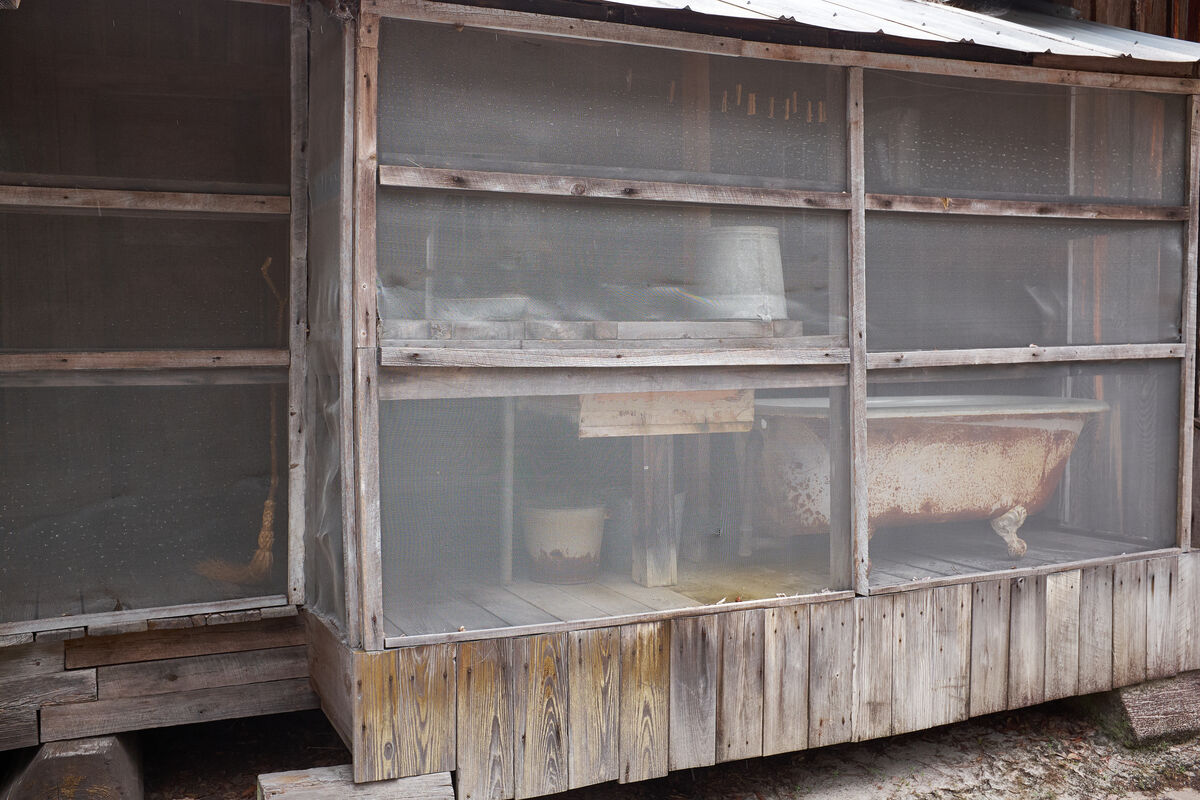
(Download)
Aug 29, 2022 13:44:33 #
Ysarex
Loc: St. Louis
selmslie wrote:
Interesting article but some results are mixed.
X-Trans pro and con is another topic. The only point I wanted to make is that unlike Bayer CFA cameras that don't show a lot of variation in processing output one raw converter to the next X-Trans does. There really are visible differences in how well fine detail is rendered from X-Trans between for example LR, PL5 and the camera. The OP started the thread expressing surprise at a visible difference in detail between processors which with X-Trans is not a surprise.
If you want to reply, then register here. Registration is free and your account is created instantly, so you can post right away.
